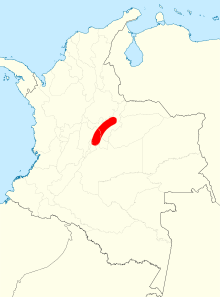| Colombian grebe | |
|---|---|
| Scientific classification | |
| Domain: | Eukaryota |
| Kingdom: | Animalia |
| Phylum: | Chordata |
| Class: | Aves |
| Order: | Podicipediformes |
| Family: | Podicipedidae |
| Genus: | Podiceps |
| Species: | †P. andinus
|
| Binomial name | |
| †Podiceps andinus (Meyer de Schauensee, 1959)
| |

| |
The Colombian grebe (Podiceps andinus), was a grebe found in the Bogotá wetlands on the Bogotá savanna in the Eastern Ranges of the Andes of Colombia. The species was still abundant in Lake Tota in 1945. The species has often been considered a subspecies of black-necked grebe (P. nigricollis),[2] and is genetically nested within it;[3] it differed from black-necked grebe most notably in having a reddish-brown (not black) foreneck, and more orangey-toned (rather than yellow) ear tufts.[2] It was flightless.[4]
The decline of the Colombian grebe is attributed to wetland drainage, siltation, pesticide pollution, disruption by reed harvesting, hunting, competition, and predation of chicks by invasive introduced rainbow trout (Oncorhynchus mykiss).[2] The primary reason was loss of habitat: drainage of wetlands and siltation resulted in higher concentrations of pollutants, causing eutrophication across Lake Tota. This destroyed the open, submergent pondweed (Potamogeton) vegetation and resulted in the formation of a dense monoculture of water weed (Elodea).[5]
By 1968, the species had declined to approximately 300 birds. Only two records of this bird were made in the 1970s; one seen 1972, and the last confirmed record from 1977 when three birds were seen. Intensive studies in 1981 and 1982 failed to find the species and it is now considered extinct.[6]
- ^ BirdLife International. (2023). "Podiceps andinus". IUCN Red List of Threatened Species. 2023: e.T22696615A221206875. doi:10.2305/IUCN.UK.2023-1.RLTS.T22696615A221206875.en. Retrieved 17 September 2024.
- ^ a b c Handbook of the birds of the world. Barcelona: Lynx Edicions. 1992. p. 194. ISBN 84-87334-10-5.
- ^ Ogawa, Lisa M.; Pulgarin, Paulo C.; Vance, Donald A.; Fjeldså, Jon; van Tuinen, Marcel (2015). "Opposing demographic histories reveal rapid evolution in grebes (Aves: Podicipedidae)". The Auk. 132 (4). Oxford University Press (OUP): 771–786. doi:10.1642/auk-14-259.1. ISSN 0004-8038.
- ^ Roots, C. 2006. Flightless Birds. Santa Barbara: Greenwood Publishing Group.
- ^ Varty et al. 1986, Fjeldsa 1993, as cited in O'Donnel and Fjeldsa 1997
- ^ (in Spanish) El Pato Zambullidor extinto de Colombia
